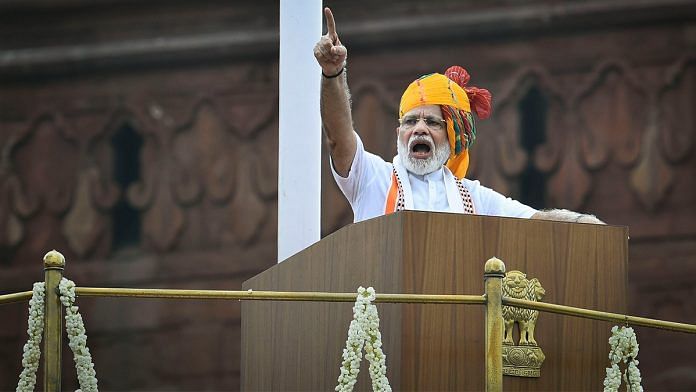New Delhi: PM Narendra Modi’s I-Day push for population control was welcomed by many economists Thursday as they cited job shortage as one of the most alarming consequences of an unmitigated rise in population. However, some also argued that India’s economic problems couldn’t be blamed on population alone.
“A small section of society, which keeps their families small, deserves respect. What they are doing is an act of patriotism,” said Modi.
“If the population is educated and healthy, the country too will be educated and healthy,” he added.
Modi said population explosion can cause new challenges for the coming generations, and called for central and state government initiatives to deal with the issue.
Also read: India’s south is protesting a bit too much and a bit unfairly
Need of the hour
Dr Amitabh Kundu, a fellow at the Research and Information System for Developing Countries, a Delhi-based policy research institute, told ThePrint that he agreed with the PM.
“With the pace of the Indian economy’s growth slowing, it’s becoming increasingly difficult to adjust the growing population of job-seekers. And our demographic dividend, which is the specialty of our economy, may soon turn against us,” added Kundu, who also chairs the committee overseeing the Swachh Bharat Mission (Rural) survey.
“If the population kept on growing at the same pace, our economy will have a huge population of jobless youth creating social issues, indulging in crime and increasing incidence of HIV-AIDS,” he said.
India, with an estimated 1.37 billion people, has the second largest population in the world and accounts for 18 per cent of its human inhabitants. By 2027, India is expected to overtake China to become the most populous country, according to the UN World Population Prospects 2019.
Economist D.K. Srivastava, chief policy adviser at EY India, said the trigger behind PM Modi’s speech was a desire to push the nation’s sluggish economic growth and take advantage of its demographic dividend.
“The general idea is to increase savings rates, which requires the average size of households to shrink. As the average household size will go down, the savings, per person, will increase,” he added. “Hence, consumption will increase to revive the economy.”
However, Amir Ullah Khan, a development and trade economist, said all of India’s economic ills couldn’t be blamed on its population.
“India is facing the problem of ‘middle-income trap’, where growth has slowed, unlike in China, Brazil, and other countries, which started growing from low-growth economies (just like India) but grew faster, for decades,” said Khan. “India only grew at a fast pace for a decade and then it got trapped,” he added.
“PM Modi has put all the blame on population growth, defending his damaging moves like GST and demonetisation, which actually crashed the economy,” Khan said. “The PM’s stand is a populist one… We all know population is high but we cannot blame it for all economic problems.”
A two-child norm?
India’s Total Fertility Rate (TFR), a measure of population growth, dropped from 3.4 in 1992-93 to 2.2 in 2015-16, but continues to be high in states like Rajasthan, Uttar Pradesh and Bihar (the WHO describes TFR as the “total number of children born or likely to be born to a woman in her life time if she were subject to the prevailing rate of age-specific fertility in the population”).
Several members of the Bharatiya Janta Party (BJP) have earlier called for a two-child policy to limit India’s population growth.
However, experts said India’s population problem will be better served by educating the girl child, instead of a two-child policy. Just a few years ago, China was forced to ease its one-child policy amid concerns about a rapidly aging population and a gender imbalance blamed on a preference for male children.
“There is no evidence on the effectiveness of a two-child policy,” said a spokesperson for the Population Foundation of India (PFI), an NGO.
“Similar policies in a few states (such as Bihar) have failed to bring down fertility rates to the desired level,” the spokesperson added, referring to a law that conditions poll participation on the number of children a candidate has.
“Countries like China that enforced a one-child policy had to abort the policy, having found themselves in the midst of a population crisis. In Sri Lanka, fertility rates were stabilised by simply increasing the age of marriage, a move that was made more effective by ensuring girls were educated,” the spokesperson said.
Kundu agreed. “We have seen the trend in the past that it requires no policy, but sending girls to schools, that impacts the health and wellbeing of the population,” he added. “Education helps in delaying age of marriage.”
Also read: Does Modi’s population control call signal India unable to leverage demographic dividend?




The acronym of Demand, Demography, Democracy is being given a quiet burial. The lofty targets are still there, $ 5 trillion by 2024, $ 10 trillion by 2030, this from a man who is himself deleveraging, like sailors trimming their sails when expecting a storm. However, the India story is unravelling before our eyes. Even as the railways prepare for the costly bullet train, Western Railways does not have money to repair and maintain its foot over bridges, which are used by millions of Mumbaikars each day. As Raj Kapoor would say, The show must go on …
There is no proof of success of 2 child policy…wat type of mindset does author have
Next stop for Modi: learn from Sanjay Gandhi how to control population. What a fall for this man.
Good. In his entire speech, someone could pick up one important thing to blow up.
Thanks for this clarification. All night I was worried whether the people of India may falsely think Modi made a positive policy proposal.
Now I know why he made that suggestion.